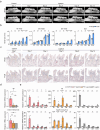The IL-33/ST2 axis is protective against acute inflammation during the course of periodontitis
- PMID: 38548743
- PMCID: PMC10978877
- DOI: 10.1038/s41467-024-46746-2
The IL-33/ST2 axis is protective against acute inflammation during the course of periodontitis
Abstract
Periodontitis, which is induced by repeated bacterial invasion and the ensuing immune reactions that follow, is the leading cause of tooth loss. Periodontal tissue is comprised of four different components, each with potential role in pathogenesis, however, most studies on immune responses focus on gingival tissue. Here, we present a modified ligature-induced periodontitis model in male mice to analyze the pathogenesis, which captures the complexity of periodontal tissue. We find that the inflammatory response in the peri-root tissues and the expression of IL-6 and RANKL by Thy-1.2- fibroblasts/stromal cells are prominent throughout the bone destruction phase, and present already at an early stage. The initiation phase is characterized by high levels of ST2 (encoded by Il1rl1) expression in the peri-root tissue, suggesting that the IL-33/ST2 axis is involved in the pathogenesis. Both Il1rl1- and Il33-deficient mice exhibit exacerbated bone loss in the acute phase of periodontitis, along with macrophage polarization towards a classically activated phenotype and increased neutrophil infiltration, indicating a protective role of the IL-33/ST2 axis in acute inflammation. Thus, our findings highlight the hidden role of the peri-root tissue and simultaneously advance our understanding of the etiology of periodontitis via implicating the IL-33/ST2 axis.
© 2024. The Author(s).
Conflict of interest statement
All authors declare no competing interests.
Figures







References
-
- World Health Organization. Global Oral Health Status Report: Towards Universal Health Coverage for Oral Health by 2030. (World Health Organization, 2022).
-
- Brkić Z, Pavlić V. Periodontology – the historical outline from ancient times until the 20th century. Vojnosanit Pregl. 2017;74:193–199. doi: 10.2298/VSP150612169B. - DOI
MeSH terms
Substances
LinkOut - more resources
Full Text Sources
Molecular Biology Databases
Miscellaneous

